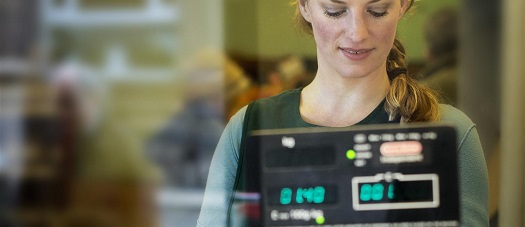By Paul Wolf
In 75 years, the world of retail technology – enabled by augmented reality, the Internet of Everything and many other technological advancements – will know us well enough to deliver exactly what we need before we can even think to ask for it.
Sound disturbing? Perhaps, but in 75 years the “creep factor” will be gone. Consumers will be so accustomed to the integration of technology into their lives that the fear associated with sharing personal information will no longer exist. If you’re over 35 years old today, you may recall an odd feeling the first time a store clerk asked for your email address. Today, the request is routine.

Data will be shared so openly and freely that retailers no longer will serve masses of consumers; they will serve you. They will compete to meet your individual needs in a convenient and natural way. And they will do this in physical stores, online and in ways we can’t yet imagine.
I mentioned physical stores. While the number of stores may diminish, physical stores will not disappear completely. Consumers enjoy interaction, and I imagine they’ll love the personalized touch of the human or virtual sales clerk in 75 years.
Today, store clerks likely have no idea who you are or what item you’re after. In 2089, as you approach a retail location, sensors will detect your presence and powerful data analytics platforms will pull together information in real time. By the time you cross the threshold, the clerk will greet you by name and already have some ideas about which workout pants would be best for the new exercise plan you’re starting next week.
Dressing rooms are a thing of the past. You’ll “try on” a stack of pre-selected virtual jeans simply by standing in front of a mirror-screen and saying “next.” Augmented reality will be so advanced in 75 years that you’ll be able to touch and feel the fabric.
Inventory, stacks of folded clothing on rows of shelves and customers walking out the door with shopping bags will be relics of the past. Products are made on demand and delivered to your home in real time. What’s more, they’re custom. No more deciding between a size 10 and size 12. The pants you select will be tailored to fit your build.
Payment is made seamlessly and securely through a digital fingerprint. No more waiting in line at a cash register. You no longer carry a wallet.
Online stores will blend into people’s lives in a similar fashion. This already is happening in places like Korea where one company has turned a flat subway wall into a virtual grocery store. Consumers point their smartphones at codes that appear on pictures of items such as milk, produce and candy bars. The items go into a virtual “cart” and are paid for over the phone. A grocery box arrives at their door just after they get home from the subway station. In 75 years it might be possible for consumers to create their own virtual stores using Google Glass or some other type of similar technology … turning any type of space into a realistic shopping experience.
Needless to say, the store will represent only one of many ways a retailer will connect with their customers. Customers won’t recognize the separation between the multiple ways retailers will serve them. All they will encounter is an unbelievable customer experience from their home, a store, on a plane or any other location they prefer.
Xerox’s Paul Wolf spends his days thinking about people – in particular, their buying and spending habits. He does this because it matters to our clients how consumers spend their time and what influences their purchasing decisions. Officially, Paul serves as vice president of Xerox Retail & Consumer products practice where he connects technology and business processes in the retail industry with people – to simplify their lives, and the lives of our clients.
Subscribe to Simplify Work and receive email updates when we publish a new article.
We asked Xerox people:
Will brick and mortar stores still exist in 75 years?
Over the next 75 years, how will the shopping experience change? How will we shop for even the most basic items?
Most people who responded to our survey saw the number of physical stores declining – perhaps even to extinction – during the next 75 years. Even those who disagreed saw a drastically different role for the retail outlets of the future.
While refills of essentials “will show up at my doorstep based on automatic monitoring by my electronic system,” “people will still prefer to go physically to stores in the neighborhood” to select items such as produce. “Local shops won’t need staff to operate, so they’ll always be open – even on holidays.”
While personal service will be key during peak hours, security equipment and robotics may progress to the point where stores restock and run themselves round the clock, and checkout lanes may disappear altogether. “You just go to a store, pick up what you want, and [an optical tracking camera on each shelf] ‘sees’ what you took and adjusts your account balance.”
Perhaps you’ll even be able to visit your favorite stores from the comfort of your own entertainment room. “You could walk into a room in which all the walls, ceilings and floors were computer screens, you could select an online store to shop from and instantly be standing inside that store.” Taking it one step further, manufacturing also might move in-house (literally) through 3D printers or similar machines. “We will have devices that will ‘create’ and ‘deliver’ whatever we want, e.g., an automatic machine will be able to deliver a drink, food, [and other] materials.” And returns are seamless. “If we don’t like how it looks … or how it tastes or for any reason we are not completely satisfied, we will have the option to ‘send it back’ through the 3D device, which will be able to reuse the materials in the item.”
Every product will be personalized, and an automated delivery system will make the world much smaller. “The selection of items will be immense and food will be fresh with virtually no waste… Shopping will be on a global level with the ability to purchase diverse items such as Icelandic spring water, American cranberry juice, Brazilian chicken, Indian rice, English salad and Australian ice cream all for one evening family meal. The items will arrive from their various origins [via drones] within a few minutes.”
In the end, despite the probability that “everything will have an online option – from the grocery store to the farm to the jewelry shop,” many people will still choose to “go shopping” in physical stores for the social or entertainment experience.




